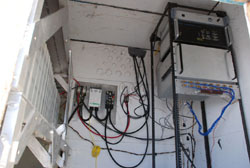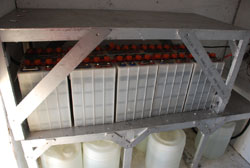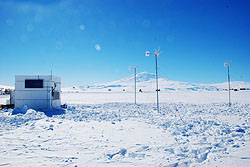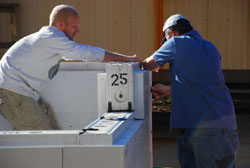Polar Experiment Network for Geospace Upper-atmosphere Investigations (PENGUIn)/ Autonomous Real-time Remote Observatory (ARRO) – Advancing the Vision for Global Studies
1. Overview of PENGUIn/ARRO
2. Brief History of ARRO Project
3. Enclosure
4. Power and Data Control Electronics
5. Scientific Instruments
1. Overview
The PENGUIn science team includes investigators seeking to understand how energy from the solar wind is transferred to the upper atmosphere at very high latitudes. The transfer of energy via this pathway is a fundamental question in space science and constitutes a critical component of space weather models. In addition to UNH and Siena College, the PENGUIn science and engineering team includes investigators from Augsburg College, U.C.-Berkeley, Dartmouth College, the University of Maryland, the New Jersey Institute of Technology, Stanford University, Virginia Tech., the University of Michigan, and Tohoku University in Japan.
In support of PENGUIn, the team at UNH analyses ULF wave data (data acquired using induction coil magnetometers) and compares these data to other observations acquired both locally and via conjugate satellites. These data are used to study a wide range of topics, including how energy is transferred through the cusp region, dynamics of radiation belt particles and how these particles interact with various waves, aspects of magnetospheric substorms, propagation of waves through the ionosphere, etc.
In addition to these studies, the group at UNH has developed the Autonomous Real-time Remote Observatory (ARRO) for polar climates, with a primary objective of being the ability to accommodate an integrated suite of instruments, in order to acquire multi-instrument observations for synergistic studies. The ARRO provides a well insulated 8’ X 8’ X 8’ enclosure where the internal system provides a temperature controlled environment, continuous power to up to 16 instruments, and near real time satellite data transfer of each instrument's data. The ARRO observatories design is similar to the Automated Geophysical Observatory (AGO), also developed use in Antarctica.
2. Brief History of ARRO Project
The ARRO project, funded by National Science Foundation (NSF) and directedby Dr. Marc Lessard as a principal investigator, is the part of the PENGUIn project. In January 2008, a prototype ARRO module was installed in McMurdo Station in Antarctica and tested for 1 year to investigate its functionality in such a harsh environment. An upgraded version of ARRO enclosure was installed and scientific instruments were added in January 2009 in order to verify its practicality as a science observatory.
 |
|
Prototype ARRO installed in Jan. 2008 |
New ARRO installed in Jan. 2009 (photo by Chris Seymour) |
3. Enclosure
The enclosure itself is designed using unique panels composed of high R-value polyurethane foam sandwiched between oriented strand board (OSB) skins. Each panel is designed using an overlapping interlock scheme which ensures the maximum thermal path through the wall of the enclosure as well as maintaining a tight seal. The enclosure is designed such that when the panels are disassembled they can be transported using a Twin Otter aircraft. Additionally, the fully assembled enclosure is sized to be transported by an LC130 aircraft, or via ground traverse. |
4. Power and Data Control Electronics
The ARRO control electronics, developed at the University of New Hampshire, are designed to provide continuous power to instrumentation. In addition, the control electronics provide the intelligence to divert excess current from the power system to control the interior temperature. The electronics can either divert power to electric heaters to provide a rapid means of increasing the temperature, or divert it to one of many water heaters encapsulated within 5 gallon water jugs. In addition to providing a good source of thermal mass, the water provides a means of taking advantage of the latent heat energy associated with the phase change of water to ice and ice to water. Essentially, the water jugs provide a form the thermal energy storage that complements the electrical energy stored in the batteries.
The ARRO Data Acquisition Unit (DAU) has the capability of acquiring data from as many as 32 instruments and can be configured to sample either an analog input or a synoptic serial channel. Via a modem developed by NAL Research, the DAU sends its data over an Iridium satellite link to a local ground station for near real time data retrieval. The DAU also has the capability to operate in a full-duplex mode to allow it to receive commands from the local ground station. In addition to the data transferred over the Iridium link, the DAU also stores the data locally on a compact flash card for data retrieval on site.
The ARRO is designed to operate with a variety of power generation inputs. The current setup installed at McMurdo Station in Antarctica uses three Marlec Rutland 910 wind turbines and 4, 120 watt Kyocera solar panels. The 3 Wind turbines are placed in parallel for redundancy in the event of a single failure and the system is designed to provide near continuous power generation for the system. The solar panels are included to provide a backup for day time operation, in case the wind turbines are unable to provide power at a given time.
 |
 |
ARRO data acquisition unit (DAU) |
ARRO batteries |
5. Scientific Instruments
As a fully operational observatory, the ARRO (and the AGOs) provide data in near real-time, revealing dynamics of the high-latitude polar ionosphere. These data include measurements of Earth's background magnetic fields, fluctuations of those magnetic fields over various frequency ranges, auroral images and information about the ionospheric conductivity. Flexibility is built-in to these systems in order to also support other types on instruments (eg. seismic, atmospheric, etc.).
In 2009 installation, 4 different kinds of instruments were connected to the ARRO DAU and their data are being transferred via Iridium data link. University of New Hampshire provided the ultra low frequency (ULF) search-coil magnetometer, which measures the time-varying earth magnetic field for investigating wave phenomena in the auroral region. The auroral study is also supported by the all-sky camera, offered by UC Berkeley. The high frequency (HF) antenna is designed by Dartmouth College to measure radio waves from the magnetosphere and the fluxgate magnetometer, provided by New Jersey Institute of Technology (NJIT), is to measure the earth’s background magnetic field.


ULF search-coil magnetometer and HF antenna at ARRO site
Related links
Institute of Earth, Ocean, and Space of University of New HampshireInterim report written by Paul Riley, the Research Engineer at University of New Hampshire



